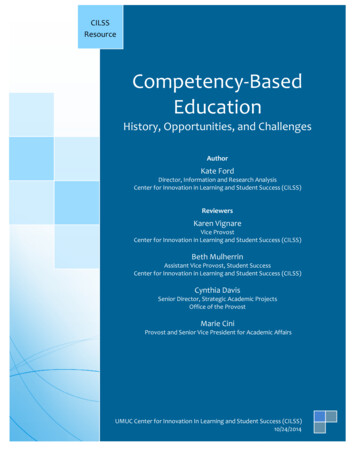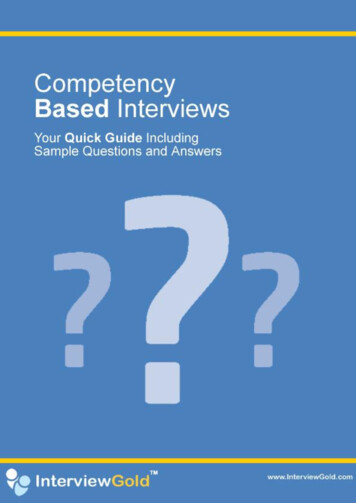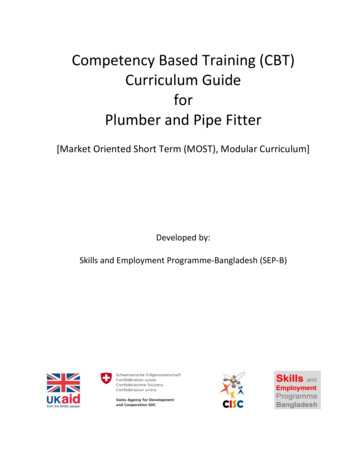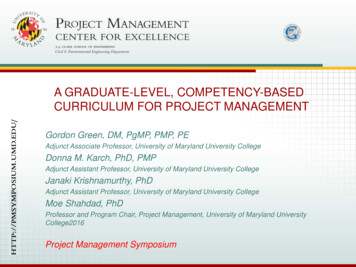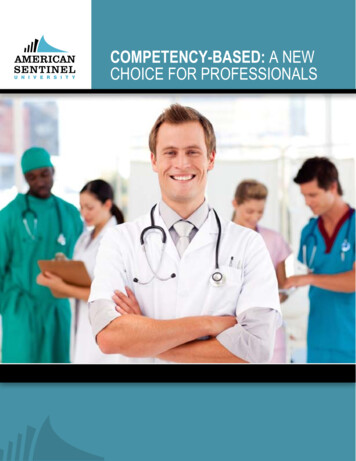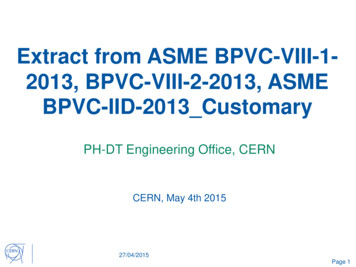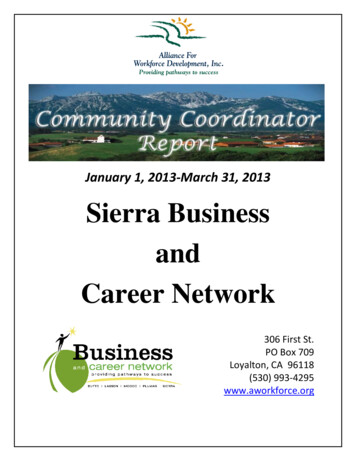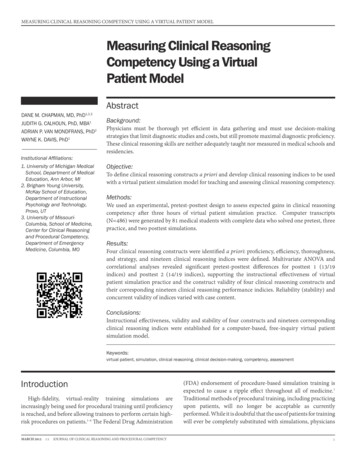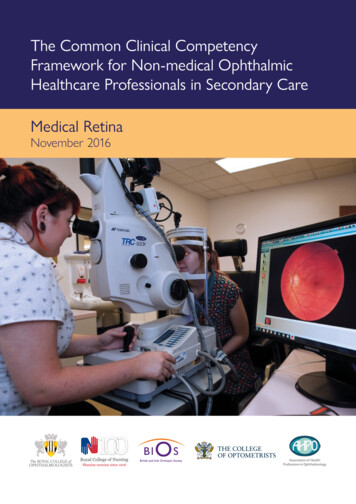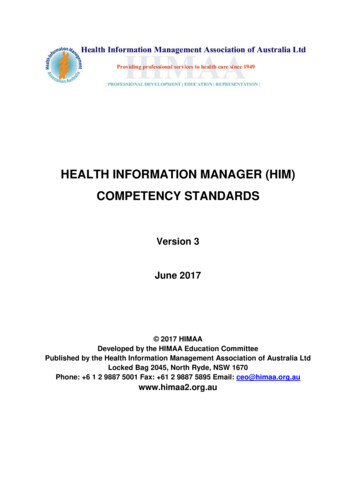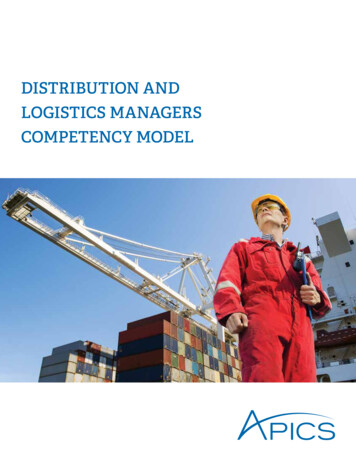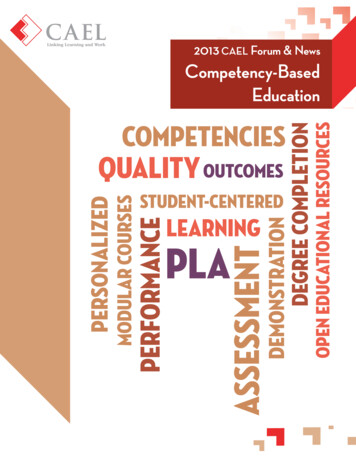
Transcription
2013 CAEL Forum & NewsCompetency-BasedEducation
CAEL 2013This report carries a Creative Commons license, which permits noncommercial re-useof the Council for Adult and Experiential Learning/CAEL’s work, or includes ourcontent in derivative works, under the following conditions: Attribution. You must clearly attribute the work to CAEL, and provide a link back towww.cael.org. Noncommercial. You may not use this work for commercial purposes without explicitprior permission from CAEL. Share Alike. If you alter, transform, or build upon this work, you may distribute theresulting work only under a license identical to this one.For the full legal code of this Creative Commons license, please visit www.creativecommons.org. If you have any questions about citing or reusingCAEL content, please contact us at cael@cael.org.
FROM THE EDITORSDear Readers,In 2012, CAEL published Competency-Based Degree Programs in the U.S.which described the history of competency-based programs and showcasedseveral models, both long-running and new. Since the release of that publication,there has been what CAEL President Pamela Tate has called a “tidal wave” ofactivity, including white papers, summits, new program development, and realmovement in terms of public policies.We are using this print issue of the CAEL Forum and News to bring yousome of these developments. In the first section, Setting the Stage, we sharean edited version of a speech by John Cavanaugh (President and CEO of theConsortium of Universities of the DC Metropolitan Area and former chancellorof the Pennsylvania State System of Higher Education) that was delivered at anational summit on assessing outcomes and competencies, and we provide afull summary of the summit itself. These articles provide a good overview of howsome leaders in the higher education community are beginning to think aboutcompetency-based assessment and degree programs, the related issues andchallenges, and what is needed to move forward.In the second section, Approaches to Competency-Based Education andAssessment, you will find articles on three brand-new competency-basedprograms: Northern Arizona University’s Personalized Learning, SouthernNew Hampshire University’s College for America, and University of MarylandUniversity College’s program in development.Finally, the section Accreditation and Federal Policy contains an interviewwith Ralph Wolff of the Western Association of Schools and Colleges on anaccreditor’s perspective of the changes in higher education, and we providean excerpt on federal financial aid solutions for competency-based approachesfrom Cracking the Credit Hour by Amy Laitinen of the New America Foundation.We hope you enjoy this issue of the CAEL Forum and News and its discussions of this new landscape in higher education today. We look forward to bringing you more on this topic in the near future.The Forum and News Editorial BoardDiana Bamford-ReesBeth DoyleBecky Klein-CollinsJudith Wertheim CAEL, 2013 Forum & News: Competency-Based Education
2013 CAEL Forum & News Competency-Based EducationTable of ContentsSetting the Stage - 1The Coming Personalization of Postsecondary Education - 2By John Cavanaugh, Consortium of Universities of the Washington Metropolitan Area; formerly of thePennsylvania State System of Higher Education (PASSHE)Assessing Outcomes & Competencies: A National Summit for Innovators - 6Summary of an event hosted by the Council for Adult and Experiential Learning in cooperation with TheCenter for Educational Measurement at Excelsior College, February 12-13, 2013.Approaches to Competency-Based Education and Assessment - 15Competency-Based Education at Northern Arizona University: PersonalizedLearning and Assessment of Learning - 16By Alison Brown and Fred Hurst, Northern Arizona UniversityCollege for America: A New Approach for a New Workforce That IsAccessible, Affordable, and Relevant - 20By Jennifer Share, College for America at Southern New Hampshire UniversityUMUC and Competency-Based Education - 25By Cynthia Davis and Marie Cini, University of Maryland University CollegeAccreditation and Federal Policy - 27A Conversation about Outcomes, Assessment, and Accreditation with RalphWolff, Western Association of Schools and Colleges (WASC) - 28By Becky Klein-Collins, CAELRecommendations on Cracking the Credit Hour by Moving from Timeto Learning - 32By Amy Laitinen, New America Foundation
Setting the Stage
The Coming Personalization of Postsecondary Education CompetenciesBy John Cavanaugh, Consortium of Universities of the Washington Metropolitan Area;formerly of the Pennsylvania State System of Higher Education (PASSHE)Following is an excerpt from the keynote speech delivered to attendees of a nationalsummit on Assessing Outcomes & Competencies on February 12, 2013 in Washington,D.C. The event was hosted by CAEL in cooperation with The Center for EducationalMeasurement at Excelsior College.Although much progress has been made inhelping returning adult students obtain college credentials, too many are still turned awaybecause they don’t fit the classic mold. Weneed a better solution. I offer one option here.Let’s Start at the Very BeginningGiving prior learning credit where it is due hasbecome a core topic in higher education today.Prior learning assessment (PLA) and massivelyopen online courses (MOOCs) are claimed tobe the killer apps that will force postsecondary education to restructure because, to paraphrase on old Dire Straits tune, now you getyour knowledge for nothing and your learningfor free. Certainly, the column inches (or theirvirtual corollary) devoted to these topics wouldlead you to believe that. It’s the new conventional wisdom, anyway. But it’s wrong.The concept and practice of massively opencourses (or, more generically, the learningopportunities of such courses) have existedsince humans started learning and teaching.What makes a massively open learning opportunity? Many people have to be able to access theinformation being presented at the same timein groups or as individuals in parallel. For free.In the past, teachers wandered around, givingtalks or lessons to very large groups of listenersin an amphitheater or on a hillside. Authenticassessment occurred in the form of active demonstration of what was learned.More recently, massively open courses havebeen made available through Sunrise Semester,1then PBS (remember Carl Sagan teaching usabout the cosmos, in a series seen by over 500million people in more than 60 countries?), theearly days of the History Channel and Discovery2Channel, and countless collections of lectures on YouTube andiTunes University. Learning assessment, through the College LevelExamination Program (CLEP)and other means, has also beenaround a long time.My point is that only the onlinedelivery part is new, and theimproved tools that this deliverysystem brings. So, we know how toprovide free content and how toevaluate the learning. It’s time weapply that experience to postsecondary education.We know howto provide freecontent and howto evaluate thelearning. It’s timewe apply thatexperience topostsecondaryeducation.PLA and MOOCs in ContemporaryPostsecondary EducationTo make this happen, we should start withthe many ways in which learning opportunitiesare available, use our experience in assessinglearning that people accrue from any of theseopportunities, and create individualized learning plans or pathways that get students to theircredential goals quicker and with more knowledge/learning to show for it. This, in turn, canincrease completion rates and help us achievethe needed attainment goals. Here are somenecessary steps:Step 1: Define Postsecondary Credentialsin Terms of Specific Learning Outcomes orCompetencies That are AssessedMany professions already define credentialson the basis of specific, assessed learning outcomes that the profession agrees are necessaryand sufficient to merit the credential. The trickwill be to go beyond these specific disciplines CAEL, 2013 Forum & News: Competency-Based Education
As long as onecan demonstratethe appropriatecontent mastery, itshould not matterwhether thelearning came fromtaking a MOOC,reading extensively,or watching KenBurns’ latest series.and to include general education. Despite lists of or not the learning the studentlearning/skills/competencies that students are demonstrates reflects the learnto acquire during their studies, few institutions ing necessary for the academicactually articulate how those skills/competen- credential being sought thatcies map onto learning (e.g., mapping learning/ matters most. However, suchskills/competencies onto specific courses), and assessments will need to beeven fewer provide evidence of their authentic monitored for quality assurance,assessment. Most institutions track general edu- which is, perhaps, most efficientcation by counting credits across distribution ly and effectively done throughrequirements, which documents little in rela- accreditation (or equivalent; seetion to to actual demonstration of learning or of Cavanaugh, 2011a, b). As long ascompetencies acquired.one can demonstrate the approMoving from credit-based to learning priate content mastery, it shouldoutcomes-based definitions of credentials is not matter whether the learnmore than just a nominal definitional change. ing came from taking a MOOC,Credentials based on credits provide no way to reading extensively, or watchingknow what the credential holder knows. They Ken Burns’ latest series.reflect only that the credential holder has colRedefining credentials tolected the minimum number of credits and tak- competencies will make it possien the minimum number of courses necessary. ble to build upon the accumulated learning thatThat is not good enough.students may already have when they arrive atArticulating specific learning outcomes also our institutions to pursue a specific credential.forces us to think through what different letter It is much more straightforward because wegrades mean (or don’t mean) in a course. If the can then specify the necessary prior learningacquisition of certain minimum levels of learn- for each step, from first term through variousing must occur for the student to be successful transfer-in points along the way, to final achievein the next course, and if a “C” does not reflect ment of the credential.that, but if a “C” translates into a passing grade,then what does passing the course mean if the Step 3: Designing Personalized Learningstudent has not learned the minimum neces- Pathways to Credentialssary? Similarly, if an “A” reflects learning wellThe next step is to do a learning gap analysisbeyond the minimum, and may reflect signifi- between the learning students bring with themcant levels of learning in the next course, then and the learning needed for the credential.why would a student be required to re-learn the When carefully executed, this learning gap analymaterial rather than being allowed to start from sis could provide the basis for significantly better,where they are in their learning?more focused academic and career advising.Good learning gap analysis is essential forStep 2: Meet the Student at the Edge ofidentifying the best way(s) for students to comTheir Learning.plete a postsecondary credential, and to avoidEach student comes to us at a slightly different needless retaking of courses. Accurate learningplace on the learning continuum. But we have gap analysis could also eliminate the argumentsnot realized this across disciplines other than over credit transfer based on subjective readingmathematics and English language arts. Now we of course syllabi by focusing exclusively on whatneed to expand that approach to the other areas the student does or does not know. Showingof “prior” learning that the student brings, such students where they currently are on the pathas history, critical thinking, information tech- way to the credential they want to earn for anology literacy, and social science, among oth- future occupation or career will enable themers. Learning in these areas can come from just to decide, given where they are, whether theyabout anywhere. It is the assessment of whether want to continue on that pathway or choose a CAEL, 2013 Forum & News: Competency-Based Education3
different one that may be a bettermatch between their current learning status and future requirements.Now, imagine this world. Wewould provide students, especially when they enter our institutions, with a personalized pathwayto their credential, and describein detail the knowledge they willneed to acquire, roughly in thesequence it needs to happen, inorder to get there. Imagine, further,that students would also be able toascertain what learning/knowledgewould best complement their chosen path, aswell as the knowledge that might enable themto expand the range of opportunities availableto them. That would be revolutionary.Personalized learning plans for postsecondary credentials could also significantly decreasethe time to credential completion in two ways.First, clearly documenting where the student isalong the pathway to the credential at the timeof entry would reduce the likelihood that thestudent will be required to unnecessarily repeatcourses. Second, the ability to create clear, individualized learning plans means that institutionswould need to ensure that the necessary learning opportunities are available when the student needs them. Situations in which neededcourses are not offered in a given term wouldbe unacceptable. That would likely result inmore focused curricula that would reduce students’ time to credential.Personalizedlearning plans forpostsecondarycredentials couldalso significantlydecrease thetime to credentialcompletion.Other Steps Needed for and SomeConsequences of Competency-BasedCredentials, Assessment, and IndividualizedLearning PlansNearly everything we currently do at postsecondary institutions is based on the credit hoursystem in one way or another. Not using thecredit as the basis for our teaching, workload,student progress, and business models has verysignificant implications for the way we operate.Adopting learning outcomes as the basis wouldrequire us to do the following:4 Define courses on the basis of theamount of student learning that is expected to occur. This would connect us to theEuropean Bologna Process, in which acredit is grounded in the amount of student work and learning that is expected. Understand that “courses” will haveno clear endpoint, as learning communities that were formed during thecourse continue. Redefine the faculty role to disaggregatethe teaching–learning enterprise into itsconstituent components that truly needfaculty expertise (similar to what hasoccurred in health care regarding nursesand physicians). Include student learning outcomes asone measure of faculty performancein annual evaluations and for tenureand promotion. Restructure the financial models,such as using differential tuition ratesdepending on the level and amountof learning (an analog of the currentapproach of charging per credit), charging a flat amount over a specific periodof time (the approach used by WesternGovernors University), or some other,blended approach. Tuition and feescould also be set as a function of thetype of credential the student is seeking.Institutional and unit funding could bebased on course or credential completion, analyses of the cost of providingstudent learning opportunities, or otheralternative. Redefine the basis for accreditationfrom the institution level only to includenon-college/university content providers (Cavanaugh, 2011a, b). The reasonis that the boundary condition fordelivering and certifying competencybased credentials, the certification ofknowledge for the credential, may notbe limited to traditional institutions. In CAEL, 2013 Forum & News: Competency-Based Education
that case, the quality assurance processthat we have ascribed to accreditationwould need to include these possibilities. The role of accreditation wouldshift to quality assurance of the learningassessment process.Other professions and economic sectors havefigured this out. We can, too.Final ThoughtsIn the near term, making these changes willbe easier for institutions that have greater flexibility to change. I am heartened by the manyfaculty and administrators who are creating theinnovative approaches to make the changesreal, and to embed them in the culture of theirrespective institutions.Those institutions that are able to completethe steps I have laid out will be able to providestudents with superior advising and clearer pathways to achieving the academic credentials thatstudents seek. And they will likely be able to dothat in a more cost-effective manner than theircompetitors. The outcome is likely to be enrollment shifts away from traditional institutionsthat fail to adapt to the changing demographicsand needs of students to those that do adapt.I also believe it is likely that we will seeincreased collaboration across organizations,whether across traditional institutions thatredefine their niches or to public–private partnerships with a collaboration among entitiesthat are specialists in each arena.We know the elements of most of what weneed to do. Now let’s work together and helpeach other create the ones we don’t.Endnotes1Sunrise Semester was an American television series that aired on CBS from 1957 to 1982. It was produced in conjunction with New York University.ReferencesCavanaugh, J. C. (2011, December 13). The future of accreditation: When learners do it themselves.Closing plenary address, Middle States Commission on Higher Education, Washington, D.C.Retrieved from ationCavanaugh.pdfCavanaugh, J. C. (2011, December 14). Accreditation in an era of open resources. InsideHigher Education . Retrieved from n-resources CAEL, 2013 Forum & News: Competency-Based Education5
Assessing Outcomes & Competencies:A National Summit for InnovatorsSummary of an event hosted by CAEL in cooperation with The Center for EducationalMeasurement at Excelsior CollegeWashington, DC, February 12-13, 2013Introduction and BackgroundIn February 2013, the Council for Adult andExperiential Learning (CAEL) and The Centerfor Educational Measurement at ExcelsiorCollege hosted a national summit on “AssessingOutcomes & Competencies.” The overall purpose of the event was for national experts todiscuss the transformation that is rapidly takingplace in higher education as increasing numbers of adult learners are pursuing college-levellearning from a variety of sources, as new providers of learning content and assessment areemerging, and as states’ higher education systems face shrinking budgets. (See appendix forlist of attendees.)CAEL President and CEO Pamela Tate, inintroducing the event, said that even thoughmany attending this summit have been doingassessment of learning and competencies fordecades, it has taken until now for those in themainstream to take note of this and recognizeassessment of competencies as not only animportant feature of high quality postsecondary education but also a central strategy in adultdegree completion. In June 2012, CAEL published Competency-Based Degree Programsin the U.S.: Postsecondary Credentials forMeasurable Student Learning and Performance,which showcased several models for offeringdegrees based on student competencies ratherthan accumulated credit hours,1 and less thanone year later, Tate described what she calleda “tidal wave” of interest in competency-basededucation and assessments.The objectives of the summit included: Gaining a deeper understanding ofthe proven tools and processes thatalready exist to validate learning and6that meet higher education’s expectations for rigor, integrity, and security;also, leveraging these exist
UMUC and Competency-Based Education - 25 By Cynthia Davis and Marie Cini, University of Maryland University College Accreditation and Federal Policy - 27 A Conversation about Outcomes, Assessment, and Accreditation with Ralph Wolff
